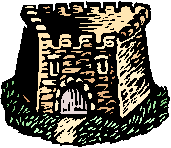

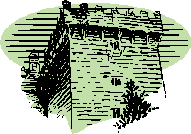
 |
|
 |
The Normans Arrive
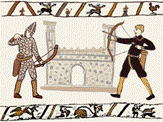
The Domesday survey states that in the time of King Edward I, the land around here was ‘waste land’, which probably meant it was no longer under cultivation due to Welsh raids and therefore the King got no taxes from the land!
After the conquest much of the present county of Shropshire,
including Ruyton, Wykey and Felton, were given to the Lordship of Earl Roger of Montgomery and areas which had been in the hands of the Welsh increased in value.
The first mention of a church in Ruyton was a chapel in the parish of Baschurch between 1129-1148. The style of the early part of the church belongs to a period probably not earlier than 1120, so the erection can be dated as between 1120 and 1148. In the troubles times of King Stephen, churches in the Marches were built by laymen and consecrated by the Bishops of Lichfield and Hereford “as protection for the poor and having respect to the warlike troubles of the time”.
The Castle is pretty certain to have been built at the same time as the church - after William Fitzallen had turned out the Welshman, Rhirid Flaidd and his family. By the time of his death in 1160, Fitzallen had taken passion of Oswestry from the Welsh and was Lord of the Manors of Felton, Wykey and Ruyton. He united the three manors and gave them to John Le Strange I. The fact that there was a castle here was the reason the newly united manors took the name Ruyton.
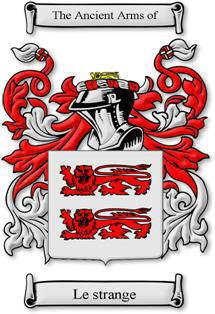
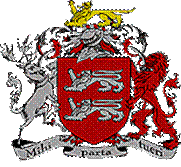 John le
Strange, 1st Lord of Knockin created the earliest known coat of arms by applying
its red background when he displayed two argent lions passant. Attached to this
the blood thirsty motto ‘mihi parta tueri’
John le
Strange, 1st Lord of Knockin created the earliest known coat of arms by applying
its red background when he displayed two argent lions passant. Attached to this
the blood thirsty motto ‘mihi parta tueri’
(I will fight for/defend what is mine)
Once you have a church you have a ‘proper’ village.
In 1212, John Le Strange, ‘Lord of Knokyn and of Ruton’… did damage to the prince (Llewellyn of Wales)'s people” and as a result the Welsh Prince came and demolished much of the castle and captured people from Ruyton.
By 1230-1240 Ruyton had become an independent parish with its own Parson Walter. Baschurch was in the hands of Shrewsbury Abbey and Felton, under another branch of the Le Strange family and had its own church.
In 1272, when an area for a churchyard and the advowson (the right to nominate a person to hold a church office in a parish) of the church were given to Haughmond, and the castle was reported to be in ruins.
The castle was not mentioned in 1299 when there was a fine imposed on the manor. 19th Century local historian, Robert Lloyd Kenyon, thought it was probably not built until after 1302 when it was acquired by the Earl of Arundel.
When, in 1301, Edmund Earl of Arundel bought Ruyton from John Le Strange, 5th Earl of Knockin, he obviously saw the potential of a village bounded by the Perry to the north and east and with a substantial castle with a commanding view of the surrounding countryside.
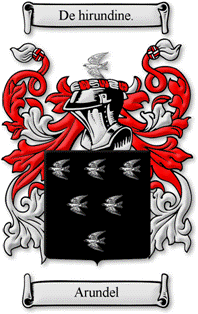 The Earldom of Arundel, in
the peerage of England, is the oldest extant Earldom and perhaps the oldest
extant title. It is currently held by the Duke of Norfolk, and is used by his
heir as a courtesy title. The title Earl of Arundel was first created in 1138
for the Norman baron —William D’Aubigny Until the mid-13th Century, the Earls
were also frequently known as Earl of Sussex, until this title fell into disuse.
At about the same time, the Earldom fell to the originally Breton Fitzalan
family, a younger branch of which went on to become the Stuart family which
later ruled Scotland.
The Earldom of Arundel, in
the peerage of England, is the oldest extant Earldom and perhaps the oldest
extant title. It is currently held by the Duke of Norfolk, and is used by his
heir as a courtesy title. The title Earl of Arundel was first created in 1138
for the Norman baron —William D’Aubigny Until the mid-13th Century, the Earls
were also frequently known as Earl of Sussex, until this title fell into disuse.
At about the same time, the Earldom fell to the originally Breton Fitzalan
family, a younger branch of which went on to become the Stuart family which
later ruled Scotland.
It is suggested that the name Arundel comes from the French 'hirondell' for the birds swallow or martin as they are incorporated in the coat of arms of the Earls of Arundel. The motto translates as
From the Swallow.
In 1308 Arundel created the new borough of Ruyton, with the laws and customs of the new town of Bristol and its citizens to be equal to those of Shrewsbury and Hereford. It was likely that at this stage the castle was rebuilt and greatly strengthened and a stone building added to the northwest. The Ruyton mace of that period bears the royal coat of arms of King Edward II as pictured below right.
 Nigel
Baker believes the new Borough of Ruyton, Nova Ville de Ruyton, would have
consisted of burgages (house and garden) lining the main street extending
westwards from the church and castle, with a triangular market place or green,
below the church. In 1832 Mr. T.W. Jenkyn, a non-conformist minister, was given
permission to preach on “the Bailey in front of the Admiral Benbow” a reminder
of the Castle environs.
Nigel
Baker believes the new Borough of Ruyton, Nova Ville de Ruyton, would have
consisted of burgages (house and garden) lining the main street extending
westwards from the church and castle, with a triangular market place or green,
below the church. In 1832 Mr. T.W. Jenkyn, a non-conformist minister, was given
permission to preach on “the Bailey in front of the Admiral Benbow” a reminder
of the Castle environs.
The Church and Castle were part of the old township of Ruyton which remained outside the jurisdiction of the new borough.
The castle was defensible in 1313 when the service of half a Knight’s fee was due to the Earl from half the Manor of Withyford near Shawbury and was returnable to Ruyton Castle.
In 1357 Thomas Barding was fined 12 pence for not doing his appointed work on the castle. Michael Jackson (1988) concluded masonry from the castle was used to repair the church in the early 15th century.
In 1364 when an empty ‘messuage’ is referred to ‘under the castle.’ This is the first indication that someone had made use of the remaining walls to construct a dwelling within the castle keep.
In 1397 an Act of Parliament declared Chester a principality and lists the lands included in the mini kingdom among them, “The Eleven towns and its Castle”. The castle was kept up at the time but of little importance.
In 1777 the plot of land containing the castle ruins and a ‘small tenement’ was shown on the map and sale details of the Craven Estates. Both early 18th century pictures below show the castle cottages.
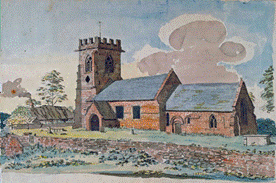
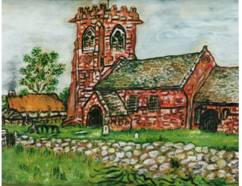
The 19th Century Restoration of Ruyton Castle Ruins
In December 1876, Mr. Richard Rowlands Minton of Clifton House offered to sell the land containing the castle ruins to the church for an extension to the churchyard. The land included ‘two inferior dwellings” within the ruins.
In Ruyton the vicar at the time, Rev. Frederick Paget Wilkinson, was very keen to have the castle investigated and to preserve the remains as an object of historic interest. Progress of the archaeological excavations were reported in the Ellesmere Rurideanical Parish Papers (parish magazine).
The tower of the castle was discovered to be 60ft square with a paved floor on a level with the church floor. About 30ft west of the tower a window sill was discovered and foundations of a building to the north and another to the north west of the main ruins. The width of the walls was some 12-15ft thick and therefore must have been built solely for defence. Foundations for a further building were discovered on the south east corner. Three light shoots were discovered, one of which was used as a chimney for one of the cottages. It was discovered that the Norman tower had probably been built on the foundations of an earlier building on the site.
The material from the dismantled cottages was sold to pay for these excavations.